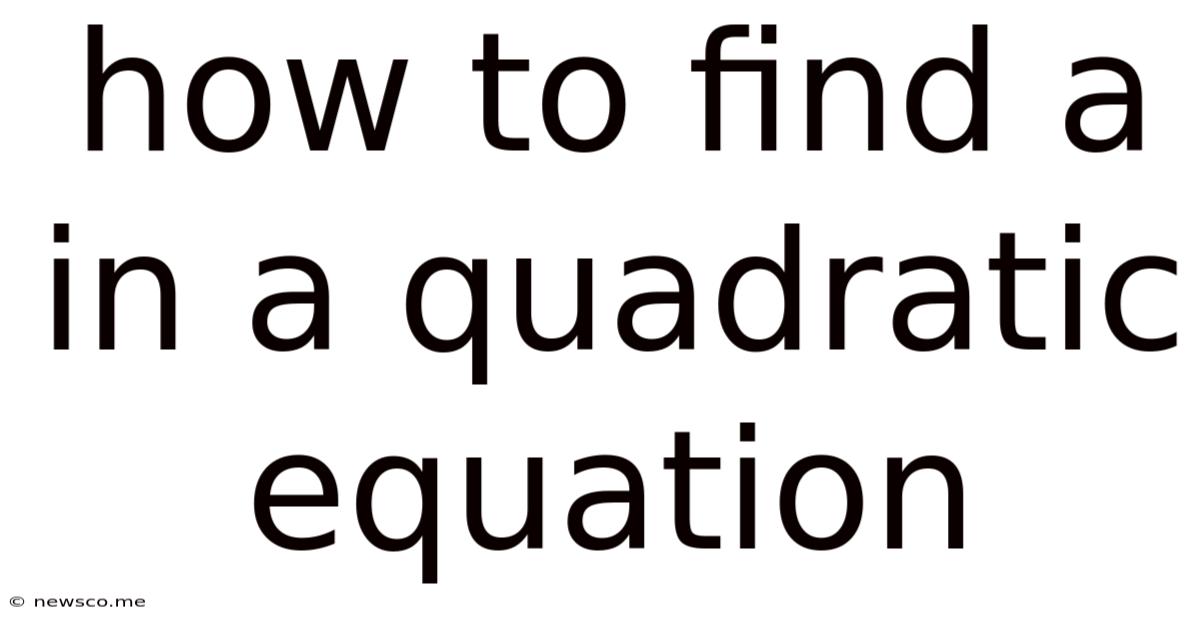How To Find A In A Quadratic Equation
News Co
Apr 19, 2025 · 4 min read

Table of Contents
How to Find the Discriminant in a Quadratic Equation: A Comprehensive Guide
Finding the discriminant in a quadratic equation is a crucial step in understanding the nature of its solutions. This seemingly simple calculation reveals whether a quadratic equation has two distinct real solutions, one repeated real solution, or two complex solutions. This article provides a comprehensive guide on how to find the discriminant, interpreting its value, and applying this knowledge to solve various quadratic equations. We'll explore the underlying theory, provide step-by-step examples, and address common misconceptions.
Understanding the Quadratic Equation
Before diving into the discriminant, let's review the standard form of a quadratic equation:
ax² + bx + c = 0
Where:
- a, b, and c are real numbers.
- a ≠ 0 (If a were 0, it wouldn't be a quadratic equation).
- x represents the unknown variable.
This equation represents a parabola when graphed. The solutions (or roots) of the equation represent the x-intercepts of this parabola – the points where the parabola intersects the x-axis.
Introducing the Discriminant
The discriminant, denoted by Δ (delta), is a part of the quadratic formula. It's given by the expression:
Δ = b² - 4ac
The discriminant is the portion of the quadratic formula under the square root. Its value directly determines the nature of the solutions to the quadratic equation.
Interpreting the Discriminant's Value
The value of the discriminant dictates the type of solutions the quadratic equation possesses:
-
Δ > 0 (Positive Discriminant): The equation has two distinct real roots. This means the parabola intersects the x-axis at two different points.
-
Δ = 0 (Zero Discriminant): The equation has one repeated real root (or a double root). This means the parabola touches the x-axis at exactly one point – the vertex of the parabola.
-
Δ < 0 (Negative Discriminant): The equation has two complex conjugate roots. These roots are complex numbers, meaning they involve the imaginary unit 'i' (where i² = -1). Geometrically, this means the parabola doesn't intersect the x-axis.
Step-by-Step Examples: Finding and Interpreting the Discriminant
Let's work through several examples to solidify our understanding.
Example 1: Two Distinct Real Roots
Solve the quadratic equation: 3x² - 7x + 2 = 0
-
Identify a, b, and c:
- a = 3
- b = -7
- c = 2
-
Calculate the discriminant (Δ): Δ = b² - 4ac = (-7)² - 4(3)(2) = 49 - 24 = 25
-
Interpret the result: Since Δ = 25 > 0, the equation has two distinct real roots.
Example 2: One Repeated Real Root
Solve the quadratic equation: x² - 6x + 9 = 0
-
Identify a, b, and c:
- a = 1
- b = -6
- c = 9
-
Calculate the discriminant (Δ): Δ = b² - 4ac = (-6)² - 4(1)(9) = 36 - 36 = 0
-
Interpret the result: Since Δ = 0, the equation has one repeated real root.
Example 3: Two Complex Conjugate Roots
Solve the quadratic equation: x² + 4x + 5 = 0
-
Identify a, b, and c:
- a = 1
- b = 4
- c = 5
-
Calculate the discriminant (Δ): Δ = b² - 4ac = (4)² - 4(1)(5) = 16 - 20 = -4
-
Interpret the result: Since Δ = -4 < 0, the equation has two complex conjugate roots.
The Quadratic Formula and the Discriminant
The discriminant is intrinsically linked to the quadratic formula, which provides a general solution for quadratic equations:
x = (-b ± √(b² - 4ac)) / 2a
Notice that the expression under the square root is precisely the discriminant (Δ). The quadratic formula, therefore, directly utilizes the discriminant to determine the roots.
Advanced Applications and Considerations
The discriminant's utility extends beyond simply determining the nature of the roots. It plays a vital role in various mathematical applications:
-
Determining the Tangency of a Line and a Parabola: If a line intersects a parabola at exactly one point, the discriminant of the resulting quadratic equation will be zero.
-
Analyzing the Existence of Solutions in Systems of Equations: The discriminant can help determine if a system of equations involving quadratics has real or complex solutions.
-
Optimization Problems: In calculus, the discriminant can be used to analyze the nature of critical points in optimization problems.
Common Mistakes and How to Avoid Them
-
Incorrectly Identifying a, b, and c: Ensure you accurately identify the coefficients a, b, and c from the standard form of the quadratic equation before calculating the discriminant. Pay close attention to signs (positive or negative).
-
Calculation Errors: Carefully perform the arithmetic operations involved in calculating the discriminant. Double-check your work to minimize errors.
-
Misinterpreting the Discriminant's Value: Clearly understand the implications of a positive, zero, or negative discriminant concerning the nature of the roots.
Conclusion: Mastering the Discriminant
The discriminant is a fundamental concept in algebra, providing valuable insights into the solutions of quadratic equations. By understanding how to calculate and interpret the discriminant, you gain a deeper understanding of quadratic equations and their behavior. This knowledge is crucial for solving various mathematical problems and lays a solid foundation for more advanced algebraic concepts. Practice working through various examples to build your confidence and proficiency. Remember to always double-check your calculations to ensure accuracy. With consistent practice and attention to detail, mastering the discriminant will become second nature.
Latest Posts
Related Post
Thank you for visiting our website which covers about How To Find A In A Quadratic Equation . We hope the information provided has been useful to you. Feel free to contact us if you have any questions or need further assistance. See you next time and don't miss to bookmark.